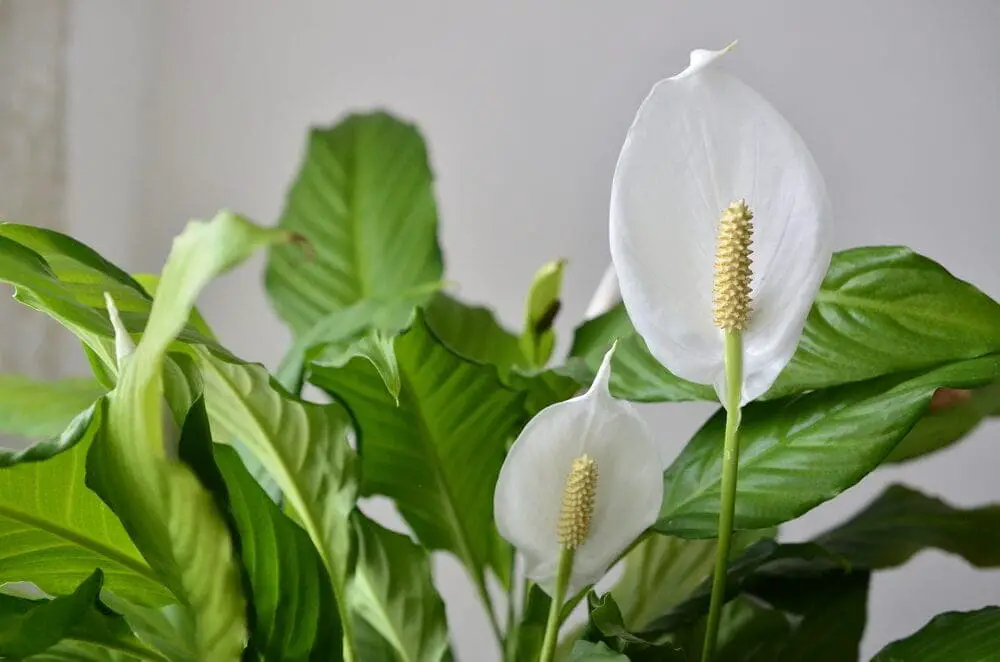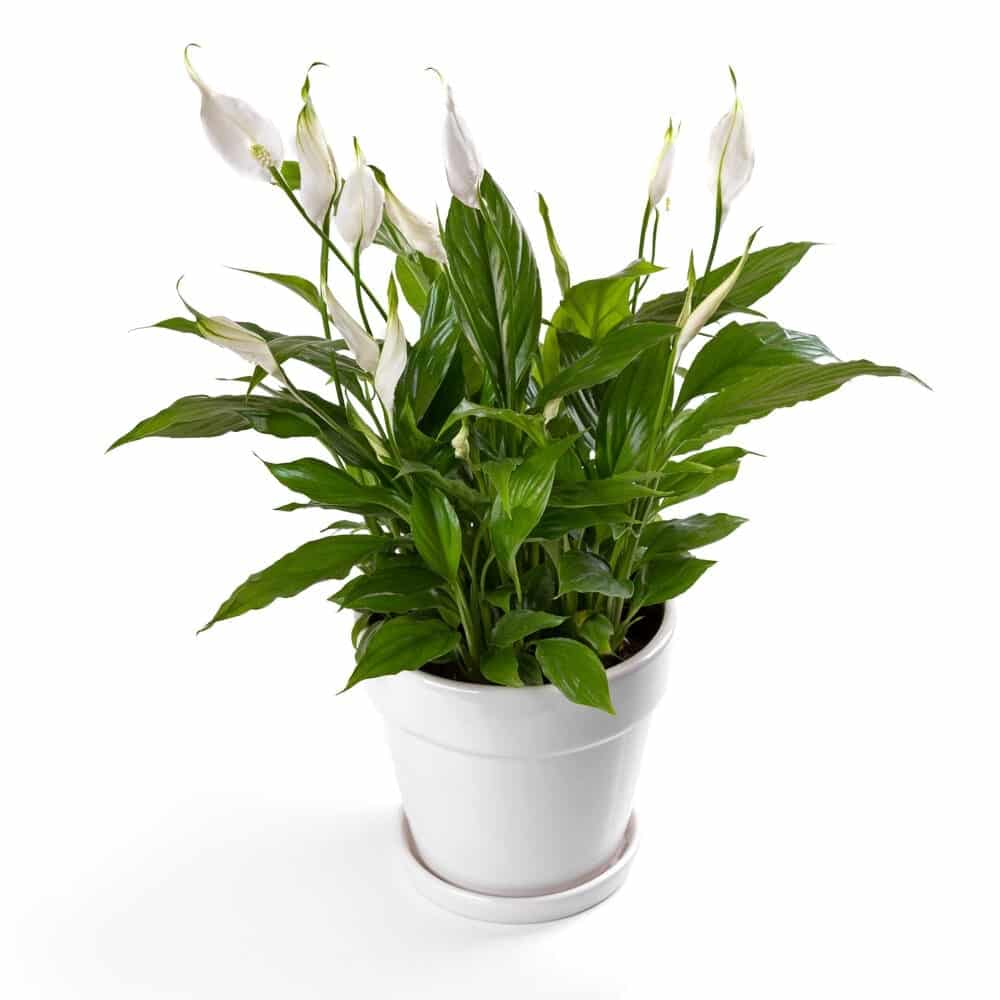If you want to grow a peace lily plant in your home, there are lots of things that you’ll need to know about caring for it.
The more you learn about these plants, the easier it will be to grow yours without any issues.
Peace Lily Care & Growing Guide
To grow a beautiful and blooming peace lily, there are some things you need to know. Here are 10 important tips when it comes to growing a peace lily.
1. Light Requirement
It is crucial that you find a place for your peace lily that is not in direct sunlight during the afternoon hours. You’ll still want the area the plant is in to have a decent amount of light though.
You will know that your peace lily needs more light if you don’t see any flowers forming on it. This type of plant doesn’t need much light, but you cannot deprive it of light altogether.
If your peace lily is getting too much light, you will notice the tips of the leaves taking on a dark yellow, almost brown coloration. This means that you will need to find another place for the plant that isn’t quite so bright.
You can put peace lilies under fluorescent lighting, but you need to make sure that it is at least six feet from a window that faces either north or west.
2. Water
When you are caring for a peace lily, you’ll want to water it once the leaves start drooping just a little bit. These plants will let you know when they need water, which makes taking care of it that much easier.
It is a good idea to water your plant once or twice a week; you want to maintain moist soil but not completely soak it. When summer rolls around, you can spray the leaves with distilled water. You won’t have to worry about watering your peace lily as much in the winter months.
You can actually go a while without watering this plant and still be able to save it. Just make sure that you give it a nice drink of water immediately. Unless you have gone a whole month without watering the plant, you can breathe life back into it.
Keep in mind that it is never a good idea to use water that contains any amount of chlorine. If you are using tap water, let it sit overnight so the chlorine evaporates.
3. Climate
Peace lilies grow in tropical climates, usually in rainforests where the weather is consistently host and moist. Most people cannot leave these plants outside throughout the entire year, unless they live in a tropical climate. It is important to take them inside once it starts getting chilly outside and temperature drops.
4. Soil
If you really want your peace lily to thrive, you’ll want to keep it in organic potting soil once you are ready to replant. It is best to use peat-based soil with composted bark. This will provide the plant with all the nutrients it needs to stay healthy.
The soil that you put your peace lily in has to be fairly light so that drainage doesn’t become an issue. You don’t want the soil to have any noticeable odor whatsoever. In the wild, these plants almost always have decaying plant matter on them. This is why it is so important for you to use compost with yours.

5. Temperature
One of the reasons that peace lilies are so easy to care for is that they tend to do well in the average indoor temperature. The ambient temperature should drop below 65 degrees Fahrenheit or go above 85 degrees Fahrenheit.
Peace lilies cannot survive in temperatures of less than 45 degrees Fahrenheit. Make sure that you keep these plants away from any appliances that give off a lot of hot or cold air. You’ll want to keep them indoors for a majority of the year.
6. Repotting
When you are ready to repot your peace lily, you’ll need to do so with a pot that is about an inch or two larger than the one it is in now. Putting your plant in a container that is too big can actually lead to root rot due to the excess moisture buildup.
You’ll also want to use some mesh material to cover the pot’s drainage hole. This will prevent the mix from coming out, which is the last thing you want. Make sure that you give the plant a nice drink of water an hour prior to starting this process.
Once you have your slightly larger container, you can put the potting mix in. You’ll only want to put in enough so that the plant’s root ball is submerged not more than an inch from the rim of the container.
You need to be very careful when transferring the plant from the pot it is currently sitting in. Firmly but gently coax the plant from its roots.
Slide the plant into its new container slowly and carefully. Make sure that potting mix is covering the root ball all around. Give the plant just a little bit of water so that the settle soils thoroughly.
Keep the peace lily in an area with a good amount of shade for two days. You shouldn’t panic if you star to notice the plant looking less than stellar—this is normal. You also don’t want to use any fertilizer for the first two months after repotting. It will need some time to adjust to its new container.
7. Speed of Growth
Peace lilies grow fairly quickly when given a moderate amount of light, but they grow incredibly slowly under lowlight conditions.
A fully grown peace lily can be anywhere from 18 to 24 inches tall, which is fairly impressive. Keep in mind that the amount of light you give your plant plays an important role in how quickly and large it will grow.
8. Height & Spread
You can get a peace lily to grow anywhere from one to four feet tall and up to six feet wide. The average size of these plants is 24 to 40 inches tall, but there are other variants that can get up to 50 inches tall.
9. Flowers
The peace lily gets its name from its white flowers, which bring to mind a flag that a cartoon character might waive to signify their surrender. White is also just generally a color that is closely associated with peace—think of the white dove.
The flowers of this plant stand erect far above the leaves, seemingly reaching toward the sky. If your peace lily is truly thriving, you should notice bright white colored leaves that are fairly large. These flowers can be anywhere from 3 to 12 inches long.
These plants produce flowers throughout the entire year, giving you a stunningly beautiful plant through all of the seasons.
10. Trimming
You will also need to trim any leaves on your peace lily that are clearly not healthy. If a leaf has turned a dark brown color, you’ll need to trim them off. Keeping these leaves will only serve to unnecessarily burden the plant. This can make it more difficult for the plant to grow normally.
Make sure that you use pruning shears when trimming any dead leaves off the plant. The shears should be completely clean before you start using them. Stay close to the soil level and keep your cuts as clean as possible. This will ensure that the healthy parts of your plant stay intact.

Is the Peace Lily Poisonous?
While the peace lily is quite a beautiful plant, it can be very dangerous and even lethal if ingested. Both humans and common house pets can suffer some pretty serious consequences from eating these plants.
Humans, as well as cats and dogs, can experience a variety of unpleasant effects from eating almost any part of a peace lily. If a person eats some of this plant, they can experience swelling of the lips and mouth, vomiting, diarrhea, and severe nausea.
If you notice your cat or dog eating a peace lily, you’ll want to call your veterinarian right away. There is a good chance that they will ask you to induce vomiting immediately with some hydrogen peroxide.
Some of the signs of peace lily poisoning in cats and dogs include:
- Excessive drooling
- Lack of appetite
- Lethargic behavior
- Vomiting
- Diarrhea
You will probably have to take your pet to the veterinarian if they eat even a little bit of a peace lily. The veterinarian can administer activated charcoal to reduce the toxic effects of this plant.
It is not a particularly good idea to keep peace lilies in your home if you have cats or dogs. You simply do not want to risk them eating any of these plants, as they are very toxic to them. You’ll also have to be careful about keeping them in the house if you have small children.
Can Peace Lilies be Grown in Water?
If you want to grow a peace lily in water, the first thing you’ll need is a betta vase. Take the peace lily from its current container and shake off the loose soil. You’ll also want to wash the roots to make sure all of the soil is gone.
Fill up the vase with distilled water that is room temperature. This will prevent the roots from going into shock. You’ll need to have a plastic insert covering the roots so that the plant stays in place nicely.
How to get Peace Lilies to Flower
If you are having trouble with getting your peace lily to flower, you’ll need to make sure that you are using the proper soil. These plants need light soil that can drain easily. You also need a good amount of organic material/compost to encourage flowering.
Water your peace lily a couple of times each week with distilled water (no chlorine or other chemicals at all). You’ll also want to give your plant some fertilizer every couple of months. Choose a fertilizer that is meant for houseplants.
Common Peace Lily Diseases
Peace lilies are prone to disease and other problems like any other plant, including:
- Drooping: If you find that the leaves on your peace lily are drooping, it’s probably because it needs more water. It is important that you give your plant a drink of some distilled water right away. You should notice the leaves start to perk up shortly after doing this.
- Fungus gnats: These gnats can quickly kill your peace lily, so you’ll need to do everything you can to keep them away. One of the best ways to keep these pests from becoming a problem is to water the plant less. It is possible that these gnats are attracted to your plant because they are overly moist.
- Brown edges: If you notice brown edges on the leaves of your peace lily, it’s most likely due to overexposure of sunlight. You should try moving the plant to an area of your home that is isn’t quite so bright.
- Yellow leaves: When a peace lily starts developing yellow leaves, it is typically because of the natural aging process. This could also be a sign that you are giving the plant too much water.
Conclusion
- You shouldn’t keep your peace lily in direct sunlight. In fact, these plants can do well in lowlight environments.
- Peace lilies should be watered one to two times each week with distilled water. If you are going to use tap water, let it sit overnight to let the chlorine evaporate.
- These plants are native to tropical climates that are hot and sunny year round.
- When you have your peace lily inside, keep the temperature between 65 and 85 degrees Fahrenheit. These plants don’t do well in very hot or cold temperatures.
- You need to keep your peace lily in light soil that allows for easy drainage. It should contain compost as well.
- When you repot a peace lily, you should carefully slide it into a new container that is one to two inches larger than its current one.
- Peace lilies produce beautiful white cream-colored flowers that can grow up to 12 inches long.
- Make sure that you trim off any brown leaves so you aren’t putting any unnecessary strain on the plant.
- These plants are poisonous to humans, cats and dogs. You’ll therefore want to be careful about keeping any of them in your home if you have pets or small children.

Victoria is the owner and main author of hobby plants. She loves spending her free time in her garden planting and taking care of her plants. Victoria hopes you enjoy the content here!
![Why Are My Peace Lily Leaves Turning Brown? [EXPLAINED] Why Are My Peace Lily Leaves Turning Brown? [EXPLAINED]](https://www.hobbyplants.com/wp-content/uploads/2022/07/peace-lily-leaves-turning-brown-1-300x158.jpg)
![Mother Of Thousands Plant [Complete Plant Care Guide] Mother Of Thousands Plant [Complete Plant Care Guide]](https://www.hobbyplants.com/wp-content/uploads/2022/07/mother-of-thousands-plant-300x158.jpg)
![Majesty Palm Plant Care: [Complete Beginner's Guide] Majesty Palm Plant Care: [Complete Beginner's Guide]](https://www.hobbyplants.com/wp-content/uploads/2022/08/majesty-palm-care-300x158.jpg)
![Exotic Angel Plant Care: [Complete Beginner's Guide] Exotic Angel Plant Care: [Complete Beginner's Guide]](https://www.hobbyplants.com/wp-content/uploads/2022/08/exotic-angel-plant-care-300x158.jpg)
![Snow White Waffle Plant: [Complete Care Guide] Snow White Waffle Plant: [Complete Care Guide]](https://www.hobbyplants.com/wp-content/uploads/2022/08/snow-white-waffle-plant-300x158.jpg)
![Waffle Plant Care: [Complete Beginner's Guide] Waffle Plant Care: [Complete Beginner's Guide]](https://www.hobbyplants.com/wp-content/uploads/2022/08/waffle-plant-300x158.jpg)
![Bird Of Paradise Plant Care: [Complete Beginner's Guide] Bird Of Paradise Plant Care: [Complete Beginner's Guide]](https://www.hobbyplants.com/wp-content/uploads/2022/08/bird-of-paradise-plant-300x158.jpg)
![Purple Passion Plant Care: [Complete Beginner's Guide] Purple Passion Plant Care: [Complete Beginner's Guide]](https://www.hobbyplants.com/wp-content/uploads/2022/08/purple-passion-plant-care-300x158.jpg)
![China Doll Plant Care: [Complete Beginner's Guide] China Doll Plant Care: [Complete Beginner's Guide]](https://www.hobbyplants.com/wp-content/uploads/2022/09/china-doll-plant-care-300x158.jpg)
![Polka Dot Plant Care: [Complete Beginner's Guide] Polka Dot Plant Care: [Complete Beginner's Guide]](https://www.hobbyplants.com/wp-content/uploads/2022/09/polka-dot-plant-300x158.jpg)
![Mona Lisa Lipstick Plant Care: [Complete Beginner's Guide] Mona Lisa Lipstick Plant Care: [Complete Beginner's Guide]](https://www.hobbyplants.com/wp-content/uploads/2022/09/lipstick-plant-mona-lisa-300x158.jpg)
![Yucca Cane Plant Care: [Complete Beginner's Guide] Yucca Cane Plant Care: [Complete Beginner's Guide]](https://www.hobbyplants.com/wp-content/uploads/2022/09/yucca-cane-plant-care-300x158.jpg)